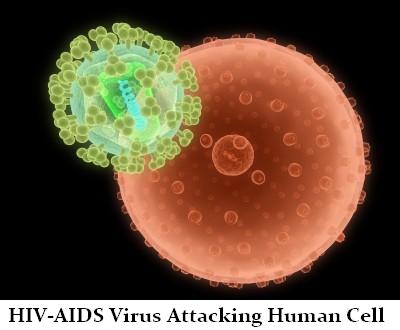- Updated on July 31, 2019
![]() By Dr. Artour Rakhimov, Alternative Health Educator and Author
By Dr. Artour Rakhimov, Alternative Health Educator and Author
 Reduced body oxygen level is a hallmark of pathological changes related to HIV/AIDS as it was reported in many medical articles (Wang et al, 1993; Mootsikapun et al, 1996; Khare & Sharland, 1999; Pellicelli et al, 2001; Zhang et al, 2002; Deshmane et al, 2009; Long et al, 2009). Furthermore, it is an established medical fact that low body-oxygen levels suppress the immune system, promotes inflammation and opportunistic infections amplified by the HIV-AIDS virus. Hence, it is logical to assume that increased body-oxygen content will help to reduce the effects caused by the HIV-AIDS virus.
Reduced body oxygen level is a hallmark of pathological changes related to HIV/AIDS as it was reported in many medical articles (Wang et al, 1993; Mootsikapun et al, 1996; Khare & Sharland, 1999; Pellicelli et al, 2001; Zhang et al, 2002; Deshmane et al, 2009; Long et al, 2009). Furthermore, it is an established medical fact that low body-oxygen levels suppress the immune system, promotes inflammation and opportunistic infections amplified by the HIV-AIDS virus. Hence, it is logical to assume that increased body-oxygen content will help to reduce the effects caused by the HIV-AIDS virus.
 Soviet medical doctors had a clinical trial on HIV-AIDS patients in the Kiev Scientific and Research Institute of Epidemiology and Infectious Diseases (Ukraine). These MDs applied the Buteyko breathing therapy, as an auxiliary therapy to standard medication, to improve the immune system and increase body-oxygen content.
Soviet medical doctors had a clinical trial on HIV-AIDS patients in the Kiev Scientific and Research Institute of Epidemiology and Infectious Diseases (Ukraine). These MDs applied the Buteyko breathing therapy, as an auxiliary therapy to standard medication, to improve the immune system and increase body-oxygen content.
These doctors discovered that the body-oxygen test (Buteyko control pause test) accurately reflects the stage of the disease and symptoms of the patients and restoration of normal breathing eliminates most pronounced symptoms of the disease. The table indicates the effects of the Buteyko method on the main symptoms that the participants experienced before and after the trial. The breathing technique was used as an additional therapy to standard medical protocols. Here are the translation of the clinical trial and an official letter to the Deputy Minister of Health of Ukrainian SSR
/Translation
Official report about the clinical trial of the Buteyko method
on AIDS patients in KSRIEID (Kiev Scientific and Research Institute of Epidemiology and Infectious Diseases) during the first quarter of 1991
Authors: Drs. Frolov AF, Buteyko KP, Novosselov VA, Fedorchenko SV
During the 1st quarter of 1991, the Buteyko breathing method was tried on 7 HIV-AIDS virus carriers. Two of them had HIV-infection in the Lymphadenopathy stage. The patients were in the following age groups: 1 person – 5 years old; 5 people – 19-40 years old; 1 person – older than 40. According to the gender, there were 3 women and 4 men. The diagnosis of AIDS was confirmed by enzyme immunoassay and immunoblotting. Approximate duration of being infected with HIV virus was the following: 1 person – 5 years; 3 persons – 2 years; 1 person – 1 year, and 2 persons – 1-4 months. The Buteyko method was accompanied by symptomatic treatment (including vitamins and desensitization drugs), sessions with a psychotherapist, while 1 person was simultaneously undergoing the Sartchuk’s therapy.
All patients completed a 10-day course of the Buteyko method and experienced improvements in their health states: 5 patients on the 2nd or 3rd day of the therapy, and 2 patients on the 5th day of the therapy. In addition, 2 patients experienced the disappearance of acute depression andneurasthenia on the 2nd day of therapy. The results of the application of the Buteyko method are presented in the following table:
| No. | Symptom | Number of patients with this symptom (1983-1990) |
Effects of the Buteyko Method |
The required period of time |
||
| Reduction | Disappear. | Reduction | Disappear. | |||
| 1 | Headache | 5 | 1 | 4 | 2 days | 5-6 days |
| 2 | Lightheadedness | 2 | – | 2 | – | 3 days |
| 3 | Emotional instability | 4 | 4 | – | 2-3 days | – |
| 4 | Predisposition to crying | 3 | – | 3 | – | 2-3 days |
| 5 | Daytime sleepiness | 1 | – | 1 | – | 3 days |
| 6 | Insomnia | 3 | – | 3 | – | 2 days |
| 7 | Problems with sleep | 1 | – | 1 | – | 3 days |
| 8 | Irritability | 5 | 5 | – | 2-3 days | – |
| 9 | Possible temper outbursts | 3 | 3 | – | 2-3 days | – |
| 10 | Unfounded fears | 4 | 1 | 4 | 4 days | 2-3 days |
| 11 | Apathy | 1 | 1 | – | 5 days | – |
| 12 | Muscle twitching | 1 | – | 1 | 6 days | – |
| 13 | Quick mental fatigue | 1 | – | 1 | – | 7 days |
| 14 | Quick physical fatigue | 3 | 2 | 1 | 4-5 days | 9 days |
| 15 | Blurred vision | 1 | – | 1 | – | 6 days |
| 16 | Angina pectoris | 5 | 1 | 4 | 1 day | 5-6 days |
| 17 | Low blood pressure | 1 | – | 1 | – | 9-10 days |
| 18 | Dyspnea during exercise | 1 | – | 1 | – | 9 days |
| 19 | Heartburn | 1 | – | 1 | – | 4-5 days |
| 20 | Charlie’s horse | 1 | 1 | – | 4-5 days | – |
The results of the Buteyko treatment allow the following preliminary conclusions:
1. The use of the Buteyko method has resulted in positive symptom dynamics.
2. No side-effects or complications have been observed in patients with AIDS during the Buteyko therapy.
3. Regular psychotherapy that had been used earlier proved ineffective and the condition of four patients even worsened.
As a result of treatment in accordance with the Buteyko method, the following preliminary conclusions can be made:
1. The use of the Buteyko method has resulted in the positive dynamic of the clinical symptoms.
2. No side-effects or complications have been observed in patients with AIDS during the Buteyko therapy.
 3. Regular psychotherapy with regular methods, which had been used earlier, proved ineffective, while the health state of four patients even worsened.
3. Regular psychotherapy with regular methods, which had been used earlier, proved ineffective, while the health state of four patients even worsened.
Signatures of the trial organizers:
Director of KSRIEID, vice-Academician of Academy of Medical Sciences of USSR, Professor A. F. Frolov
Conductor of the trial K.P. Buteyko, MD
Executive of the trial V.A. Novosselov, MD
Physician of the AIDS Section of the Institute (KSRIEID) S.V. Fedorchenko, MD
Ministry of Health of UKRAINIAN SSR
(KSRIEID) Kiev Scientific and Research Institute of Epidemiology and Infectious Diseases named after L. V. Gromashevsky
4, Spusk Stepana Razina, Kiev-038, 252038, Ukraine Tel. 277-37-11
 An official letter to the Deputy Minister of Health
An official letter to the Deputy Minister of Health
of the Ukrainian SSR Mr. V. I. Shestakov
Conclusions about the results of a clinical trial
of the Buteyko method on AIDS patients
As a result of treatment in accordance with the Buteyko method in KSRIEID from January 08, 1991 to March 31, 1991, the following results were confirmed:
1. The use of the Buteyko method has resulted in improvements in clinical symptoms.
2. No side-effects or complications have been observed in patients with AIDS during the Buteyko therapy.
3. It is sensible to continue careful observations and laboratory investigations of AIDS patients and recommend the Buteyko method for further testing.
4. Regular psychotherapy that had been used earlier proved ineffective, and the health state of four patients even worsened.
Signed by Director of KSRIEID, vice-Academician of Academy of Medical Sciences of USSR, Professor A. F. Frolov
/Translated by Artour Rakhimov, PhD
Summary of findings in relation to HIV-AIDS
While testing and successfully treating HIV-AIDS patients, Russian and Ukrainian doctors found that the clinical picture in people with HIV-AIDS correlates well with the results of their DIY body-oxygen test. This makes total sense since low cell oxygenation suppresses the immune system. Therefore, correction of abnormal breathing patterns (that are present in 100% of people with HIV-AIDS) is the foundation of the therapy that addresses the true cause of HIV-AIDS: tissue hypoxia.
Studies confirmed that people with HIV-AIDS have a low body O2: HIV-AIDS abstracts.
Or go back to HIV AIDS pages
Clinical References
Deshmane SL1, Mukerjee R, Fan S, Del Valle L, Michiels C, Sweet T, Rom I, Khalili K, Rappaport J, Amini S, Sawaya BE. Activation of the oxidative stress pathway by HIV-1 Vpr leads to induction of hypoxia-inducible factor 1alpha expression, J Biol Chem. 2009 Apr 24;284(17):11364-73. doi: 10.1074/jbc.M809266200. Epub 2009 Feb 9.
Khare MD, Sharland M. Pulmonary manifestations of pediatric HIV infection, Indian J Pediatr. 1999 Nov-Dec;66(6):895-904.
Mootsikapun P1, Chetchotisakd P, Intarapoka B. Pulmonary infections in HIV infected patients, J Med Assoc Thai. 1996 Aug;79(8):477-85.
Pellicelli AM1, Barbaro G, Palmieri F, Girardi E, D’Ambrosio C, Rianda A, Barbarini G, Frigiotti D, Borgia MC, Petrosillo N. Primary pulmonary hypertension in HIV patients: a systematic review, Angiology. 2001 Jan;52(1):31-41.
Zhang W1, Liu HT. MAPK signal pathways in the regulation of cell proliferation in mammalian cells, Cell Res. 2002 Mar;12(1):9-18.
Wang MZ1, Cai BQ, Li LY, Lin JT, Su N, Yu HX, Gao H, Zhao JZ, Liu L. [Efficacy and safety of arbidol in treatment of naturally acquired influenza], Zhongguo Yi Xue Ke Xue Yuan Xue Bao. 2004 Jun;26(3):289-93.

